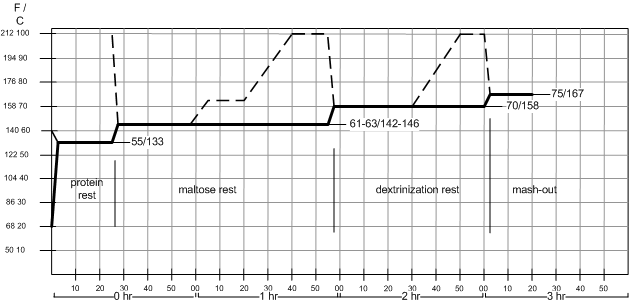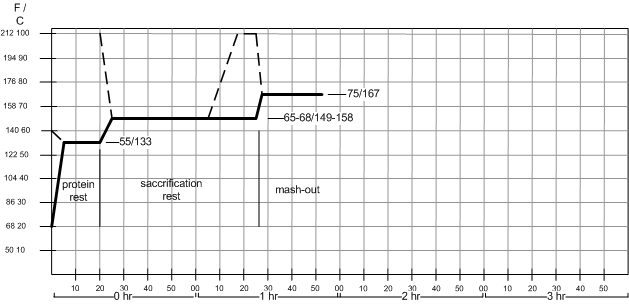Mainly to show myself the taste differences between beers brewed with a double decoction (which includes a thick decoction) and a beer brewed with a single decoction (thin decoction), I brewed 2 Maibocks this year (last year I realized that I need 2 and making a decoction experiment out of them seemed natural). The recipe was this:
- 73% Bohemian Pils
- 20% Munich Type II
- 2% acid malt
- 2.3 % CaraVienna
- 2.7% Cara Hell
- Hops to get to ~21 IBU (Tinseth formula)
Mash
The first beer (A) was brewed using a Hochkurz deoction like this:

- with these mash parameters:
- dough-in/protein rest: 54 C (131 F) for 15 min
- maltose rest: 63 C (145F); a thick decoction was pulled after 30 min
- decoction was converted at 73 C (163) and the total time from pulling to boil was 30 min
- 10 min decoction boil
- dextrinization rest 70 C (158 F) for 15 min (until iodine negative)
- 2nd decoction was pulled, brought to a boil in 12 min and boiled for 2 min
- mash-out was at 77 C (171 F)
The second beer (B) was brewed with a step infusion and thin mash-out decoction. I just noticed that when I read my notes. When coming up with the experiment I thought that it would be sufficient to check for an impact of the thick decoction where grain is actually being boiled. The mash-out seemed more important than having a true non-decoction beer.

- dough-in/protein rest at 55C (133F) for 20 min
- saccrification rest at 65.6 ( 150 F) for 45 min
- thin decoction pulled and brought to a boil within 15 min
- boiled for 5 min
- mash-out at 73 C (163 F)
Fermentation
Both beers were fermented with the same temperature profile. But the 2nd one was pitched with yeast from the first one since they were brewed about 10 days apart. The fast ferment test for the double-decocted beer (A) showed a final extract of 3.0 Plato (82% limit of attenuation) and the fast ferment test for the beer (B) showed a final extract of 3.4 Plato (80% limit of attenuation)
About 2 months later, both beers didn't show the reduction of extract during lagering that I hoped for and fresh yeast was added to kick start another fermentation. They were also moved to a 15 C area for 3 days to speed up that fermentation. At the end they reached 4.3 Plato and they were both moved back to the lagering fridge. After another 3 weeks the double-decocted beer reached 4.1 Plato and was racked to a serving keg. The single-decocted beer was still at 4.4 Plato and was moved to a 5C fridge to speed up the fermentation that was still going on during lagering. After another 2 months the single decocted beer was finally not to sweet anymore and racked to a serving keg. Its extract was now at 4.1 Plato.
Tasting
Shortly after racking the single-decocted version to the serving keg, I tasted both beers. The keg with the double-decocted version was already empty and I had to take it from a bottle. The single decocted version was taken from the keg.
double decocted Maibock vs. single decocted Maibock
There was no noticeable difference in color between the two beers. That is not surprising because the difference in decoction boil time was only 10 min (I know, I should have extended that to 30 min). The double-decocted beer showed a slight bit more haze, but only because it was actually colder (about 4C compared to the single-decocted beer that was at 8C).
The head retention was comparable, but was not evaluated due to the differences in carbonation between the beers.
The double-decocted beer was a little sweeter and maltier in its aroma. I'm hesitant to contribute this soley to the decoction. Both beers ended up being treated slightly differently towards the end of their fermentation and many of the sweet aroma notes come from compounds produced during the aging of the beer.
Both beers started malty sweet and didn't have any lingering bitterness. A balance that is typical for a Maibock. But the double-decocted beer was considered to have a more "robust" finish. While this can be a result of the additional decoction boil, it can also be the result of fermentation byproducts like higher alcohols. This "robustness" was also confirmed in degassed hydrometer samples and is thus not a result of different carbonantion. The single decocted beer seemed more "flat" in comparison.
Conclusion
While a difference between the two beers exist, it is slight and could easily caused by different fermentation parameters. But it could also be the result of the decoction. In the end this experiment neither showed that there is no difference between decocted beers, nor did it show a flavor difference that can conclusively be attributed to the mashing difference. Additional experiments are necessary for that. Such an experiment should be done between a mash that heavily uses decoctions and boils them for a longer time and a mash that does not use decoction at all but holds all the rests that the decoction mash was holding. Preferably for a daker beer as these are the beers where decoction is most common in German breweries these days.




